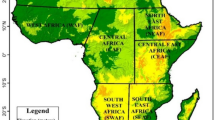Abstract
A simplified climate model based on maximum entropy production, described by a variational principle, is revisited and an analytical solution to its Euler–Lagrange equation is found. Mindful of controversy about maximum or minimum entropy production in open thermodynamical systems, we show that the solution extremizing the action integral corresponds to a maximum.
Similar content being viewed by others
Notes
Friction, however, does not coincide with entropy production rate.
The radiative budget is usually non-local, i.e., a functional of the vertical temperature profile, even in simple models when several layers of atmosphere are considered.
In the end, Ref. [36] assumes \(I(\vartheta )= \beta - \alpha \sin ^2 \vartheta \), with \(\alpha \) and \(\beta \) constants.
References
G. Paltridge, Global dynamics and climate-a system of minimum entropy exchange. Quart. J. Roy. Meteorol. Soc. 101, 475–484 (1975)
R. Goody, Maximum entropy production in climate theory. J. Atmos. Sci. 64, 2735–2739 (2007)
K. Caldeira, The maximum entropy principle: a critical discussion. Clim. Change 85, 267–269 (2007)
C. Nicolis, G. Nicolis, Stability, complexity and the maximum dissipation conjecture. Quart. J. Roy. Meteorol. Soc. 136, 1161–1169 (2010)
G. Paltridge, Thermodynamic dissipation and the global climate system. Quart. J. Roy. Meteorol. Soc. 107, 531–547 (1981)
H. Grassl, The climate at the maximum-entropy production by meridional atmospheric and oceanic heat fluxes. Quart. J. Roy. Meteorol. Soc. 107, 153–166 (1981)
A. Noda, T. Tokioka, Climates at minima of the entropy exchange rate. J. Meteorol. Soc. Jpn. 61, 894–908 (1983)
R. Lorenz, J. Lunine, P. Withers, C. McKay, Titan, Mars and Earth: Entropy production by latitudinal heat transport. Geophys. Res. Lett. 28, 415–418 (2001)
T. Pujol, J. Fort, States of maximum entropy production in a one-dimensional vertical model with convective adjustments. Tellus A 54, 363–369 (2002)
T. Pujol, Eddy heat diffusivity at maximum dissipation in a radiative-convective one-dimensional climate model. J. Meteorol. Soc. Jpn. 81, 305–315 (2003)
A. Kleidon, Beyond Gaia: thermodynamic of life and earth system functioning. Clim. Change 66, 271–319 (2004)
A. Kleidon, Nonequilibrium thermodynamics and maximum entropy production in the earth system. Naturwissenschaften 96, 653–677 (2009)
A. Kleidon, A basic introduction to the thermodynamics of the earth system far from equilibrium and maximum entropy production. Philos. T. Roy. Soc. B 365, 1303–1315 (2010)
T. Jupp, P. Cox, MEP and planetary climates: insights from a two-box climate model containing atmospheric dynamics. Philos. T. Roy. Soc. B 365, 1355–1365 (2010)
C. Herbert, D. Paillard, B. Dubrulle, Entropy production and multiple equilibria: the case of the ice-albedo feedback. Earth Syst. Dyn. 2, 13–23 (2011)
S.D. Mobbs, Extremal principles for global climate models. Quart. J. Roy. Met. Soc. 108, 535–550 (1982)
A. Kleidon, K. Fraedrich, T. Kunz, F. Lunkeit, The atmospheric circulation and the states of maximum entropy production. Geophys. Res. Lett. 30, 2223 (2003)
A. Kleidon, K. Fraedrich, E. Kirk, F. Lunkeit, Maximum entropy production and the strenght of boundary layer exchange in an atmospheric general circulation model. Geophys. Res. Lett. 33, L08709 (2006)
T. Kunz, K. Fraedrich, E. Kirk, Optimisation of simplified GCMS using circulation indices and maximum entropy production. Clim. Dyn. 30, 803–813 (2008)
S. Pascale, J. Gregory, M. Ambaum, R. Tailleux, A parametric sensitivity study of entropy production and kinetic energy dissipation using the FAMOUS AOGCM. Clim. Dyn. 38, 1211–1227 (2012)
R.C. Dewar, Maximum entropy production and the fluctuation theorem. J. Phys. A 38, L371–L381 (2005)
G. Grinstein, R. Linsker, Comments on a derivation and application of the maximum entropy production principle. J. Phys. A 40, 9717–9720 (2007)
V. Labarre, private communication (2020)
J. Li, On the extreme of internal entropy production. J. Phys. A: Math. Theor. 42, 035002 (2009)
M. Larson et al., Equilibrium beach profiles under breaking and non-breaking waves. Coast. Eng. 36, 59 (1999)
S.A. Jenkins, D.L. Inman, Thermodynamic solutions for equilibrium beach profiles. J. Geophys. Res. Oceans 111, C02003 (2006)
S. Maldonado, Do beach profiles under non-breaking waves minimize energy dissipation? J. Geophys. Res. Oceans 125, e2019JC015876 (2020)
S. Maldonado, M. Uchasara, On the thermodynamics-based equilibrium beach profile derived by Jenkins and Inman (2006). arXiv:1908.07825 [physics.geo-ph] (2019)
V. Faraoni, On the extremization of wave energy dissipation rates in equilibrium beach profiles. J. Oceanogr. (2020). https://doi.org/10.1007/s10872-020-00556-4
V. Faraoni, Maximizing friction in the erosion of glacial valleys. J. Glaciol. (2020). https://doi.org/10.1017/jog.2020.47
J.M. Harbor, A discussion of Hirano and Aniya’s (1988, 1989) explanation of glacial-valley cross profile development. Earth Surf. Process. Landf. 15, 369–377 (1990)
M. Hirano, M. Aniya, A rational explanation of cross-profile morphology for glacial valleys and of glacial valley development. Earth Surf. Process. Landf. 13, 707–716 (1988)
M. Hirano, M. Aniya, A reply to ‘a discussion of Hirano and Aniya’s (1988, 1989) explanation of glacial-valley cross profile development’ by Jonathan M. Harbor. Earth Surf. Process. Landf. 15, 379–381 (1990)
M. Hirano, M. Aniya, Response to Morgan’s comment. Earth Surf. Process. Landf. 30, 515 (2005)
F. Morgan, A note on cross-profile morphology for glacial valleys. Earth Surf. Process. Landf. 30, 513–514 (2005)
S. Murakami, A. Kitoh, Euler–Lagrange equation of the most simple 1-d climate model based on the maximum entropy production hypothesis. Quart. J. Roy. Meteorol. Soc. 131, 1529–1538 (1953)
D.M. O’Brien, G.L. Stephens, Entropy and climate. II: simple models. Quart. J. Roy. Meteorol. Soc. 121, 1773–1796 (1995)
C. Rodgers, Comments on Paltridge’s minimum entropy exchange principle. Quart. J. Roy. Meteorol. Soc. 102, 455–457 (1976)
H.J. Weber, G.B. Arfken, Essential Mathematical Methods for Physicists (Elsevier/Academic Press, Amsterdam, 2004)
Acknowledgements
We thank a referee for suggestions leading to improvements in the manuscript. This work is supported by the Natural Sciences and Engineering Research Council of Canada (Grant No. 2016-03803) and by Bishop’s University.
Author information
Authors and Affiliations
Corresponding author
Rights and permissions
About this article
Cite this article
Faraoni, V. A simplified climate model and maximum entropy production. Eur. Phys. J. Plus 135, 868 (2020). https://doi.org/10.1140/epjp/s13360-020-00879-7
Received:
Accepted:
Published:
DOI: https://doi.org/10.1140/epjp/s13360-020-00879-7




